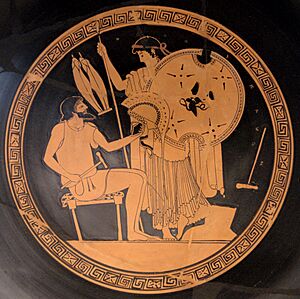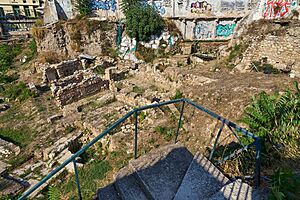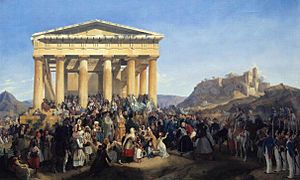Temple of Hephaestus facts for kids
Quick facts for kids Temple of Hephaestus/Theseion |
|
|---|---|
|
Ναός Ηφαίστου/Θησείο
|
|
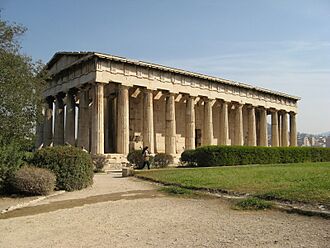
Temple of Hephaestus, Athens
|
|
| General information | |
| Architectural style | Ancient Greek and Doric |
| Town or city | Athens |
| Country | Greece |
| Coordinates | 37°58′32.22″N 23°43′17.01″E / 37.9756167°N 23.7213917°E |
| Construction started | 449 BC |
| Completed | 415 BC |
The Temple of Hephaestus is an amazing ancient Greek temple. It was built to honor Hephaestus, the Greek god of metalworking and fire. This temple is still standing strong in Athens, Greece, even after thousands of years!
It's a special kind of temple called a Doric peripteral temple. This means it has columns all around it. You can find it on a hill called Agoraios Kolonos, on the northwest side of the Agora of Athens, which was like the main marketplace of ancient Athens.
For a long time, from the 600s AD until 1834, this temple was used as a Greek Orthodox church. It was called the church of Saint George Akamates. Because it was used for so many different things over the centuries, the building has stayed in great condition.
Contents
What's in a Name?
Hephaestus was the god of metalworking, crafting, and fire. It makes sense that his temple was built in an area where many potters and metalworkers had their shops.
Before this temple, there was a smaller holy place on the same spot. It was burned down in 480 BC during the Second Persian invasion of Greece.
For a long time, people mistakenly called this temple the Theseion, or Temple of Theseus. They thought it held the remains of the famous Athenian hero Theseus. His bones were brought back to Athens in 475 BC. However, writings found inside the temple later proved it was definitely for Hephaestus.
Building the Temple
After a big battle called Plataea, the Greeks made a promise. They swore they would never rebuild the holy places the Persians destroyed. They wanted them to stay in ruins as a reminder of the war.
The people of Athens focused on rebuilding their economy first. They also worked on making their group, the Delian League, stronger.
Later, a leader named Pericles had a big idea. He wanted to make Athens the most important city for Greek power and culture. So, construction on the Temple of Hephaestus began in 449 BC.
Some experts believe the temple took about 30 years to finish. This is because money and workers were also needed for the Parthenon, another famous temple.
- The western part of the decorative carvings (called a frieze) was finished between 445–440 BC.
- Around this time, a statue of Athena Hephaistia was added next to the main statue of Hephaestus.
- The eastern frieze, the western triangular roof section (called a pediment), and some inside changes were likely done between 435–430 BC.
- The roof was finally completed, and the main statues were put in place during a time of peace, from 421–415 BC.
Temple Design and Art
We don't know the exact architect who designed the Temple of Hephaestus. So, people just call them The Hephaisteion Master.
The temple is mostly made of beautiful marble from a nearby mountain called Penteli. Only the very bottom step of the platform is made from a different stone. The sculptures are made from both Pentelic and Parian marble.
The temple is about 13.71 meters (45 feet) wide from north to south. It is about 31.78 meters (104 feet) long from east to west. It has six columns on the shorter east and west sides. There are thirteen columns along the longer north and south sides. The four corner columns are counted twice.
The temple has a front porch (pronaos), a main room (cella) for the statues, and a back porch (opisthodomos). Inside, there's another set of Doric columns.
The temple's decorations show a mix of styles. Both the front and back porches have continuous Ionic friezes. These are long bands of sculptures. Usually, Doric temples have different kinds of carvings called triglyphs.
The triangular sections (pediments) above the porches also have sculptures:
- The east pediment shows the Birth of Athena.
- The west pediment shows Hephaestus returning to Mount Olympus.
The frieze on the front porch shows a battle between Theseus and the Pallantides, with gods watching. The frieze on the back porch shows a battle between Centaurs and Lapiths.
Only 18 of the 68 square panels (called metopes) on the outside of the temple were sculpted. These were mainly on the east side. The others might have been painted.
- The ten metopes on the east side show the Labors of Heracles.
- The four easternmost metopes on the north and south sides show the Labors of Theseus.
According to an ancient writer named Pausanias, the temple held bronze statues of Athena and Hephaestus. Records show payments for two bronze statues between 421–415 BC. It's believed that a sculptor named Alcamenes made them.
In the 200s BC, a small garden was planted around the temple. It had pomegranate, myrtle, and laurel trees.
Festivals and Worship
The Temple of Hephaestus was a very important religious center. It wasn't just for the main statues inside.
Honoring Heroes and Gods
The temple's art showed important Athenian ideas. It featured the hero Theseus along with Heracles. The sculptures on the outside of the temple told stories:
- Ten panels on the east side showed the Labors of Heracles.
- Four corner panels on the north and south sides showed the deeds of Theseus.
These stories celebrated Athens's founding hero. This is why people later mistakenly called the temple the "Theseion."
An ancient writer named Plutarch tells us that in 475 BC, a general named Kimon brought what people believed were Theseus's bones back to Athens. They were buried near a gymnasium with grand ceremonies. This tomb became a sacred place where people seeking safety could go.
The Chalkeia Festival
The Chalkeia was an annual festival connected to the temple's gods, Hephaestus and Athena. It happened in late autumn. Its name means "Bronze Workers' Festival." This shows its connection to metalworkers.
At first, it was a popular public festival. Later, it was mainly celebrated by craftsmen. During the Chalkeia, artisans closed their workshops. They joined a procession, offering grain and sacrificing animals. They honored Hephaestus as the divine blacksmith. They also honored Athena as the patroness of crafts and weaving.
A key part of the Chalkeia was setting up the loom to weave a new peplos (a special robe) for Athena. On this day, priestesses and young sacred maidens began preparing the robe. It would be given to Athena at the Great Panathenaia festival nine months later. This linked the Chalkeia to Athens's important civic calendar.
The Hephaisteia Festival
The Hephaisteia was the main festival for Hephaestus in Athens. It was a big celebration that showed the god's importance to the city's creative life.
It was first held every year. But in the late 400s BC, it was changed. An ancient writing from 421/0 BC talks about new plans for the festival. It mentions traditional events like a torch race and a bull sacrifice. The torch race was especially linked to Hephaestus, as he gave fire to humans.
The Hephaisteia grew more important. By the 300s BC, it was held every five years instead of yearly. The festival included a grand procession through the city. It ended with animal sacrifices at the Temple of Hephaestus.
Hundreds of citizens took part. Special officials were chosen to organize the event. Many men were responsible for the sacrifices, procession, and contests. The festival highlighted themes of craft, fire, and unity in the city.
For example, there was a ceremony involving a bull. Later writers described Hephaestus being linked to a "bull-lifting" rite. This might have been an athletic contest. The festival helped include smiths, metalworkers, and craftsmen in the city's religious life. It gave them a public way to honor their patron god.
Importance for Metal Workers
Archaeologists have found many small offerings and tools around the temple. These include pottery pieces, metal waste, and casting molds. These findings show that ancient artisans saw this area as sacred to their trade.
Ancient writers also mentioned a "Chalkeion" (a smithy or bronze workshop) next to the temple. This suggests that craft groups or metalworking families had altars or workspaces under Hephaestus's protection.
Offerings to Hephaestus and Athena likely included tiny bronze tools and clay models of hammers and tongs. These were symbols of their work.
Civic Importance
In front of the temple, archaeologists found the remains of an altar. Sacrifices would have been performed here during festivals.
The temple's sculptures also show its importance to the city. For example, the east frieze shows Theseus's battle with the Pallantides. These were people who tried to take over Athens. The west frieze shows the battle of the Centaurs.
Experts believe these scenes are like political stories. By connecting Hephaestus's temple to other important city monuments, the temple showed Athens as a city of cleverness, order, and civilized effort.
From Temple to Church
Around 700 AD, the temple was changed into a Christian church. It was dedicated to Saint George. We don't know the exact date it became a church, but it was likely in the 600s AD.
Greek Orthodox churches often add extra names to their saints. Saint George "Akamates" has several possible meanings:
- It might come from Akamantas, the son of Theseus.
- It could mean "loiterer" or "idle one." During the Ottoman Era, the temple was only used once a year, on Saint George's feast day.
- Another idea is that the name comes from Archbishop Michael Akominatos. He might have been the first to hold a church service there.
The last church service in the temple happened on February 21, 1833. This was during the celebrations for the arrival of Otto of Greece to his new kingdom.
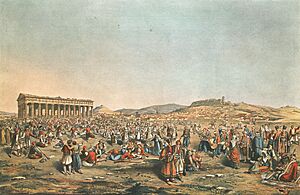
The 1800s
When Athens became the official capital of Greece in 1834, an important royal announcement was made in this temple. It was the last time Athenians gathered publicly there.
In the 1800s, the temple was used as a burial place for Europeans who were not Orthodox Christians. Many of these were philhellenes, people who loved Greece and helped in the Greek War of Independence (1821–1830).
Among those buried there was John Tweddel, a friend of Lord Elgin. Excavations also found a grave slab for George Watson with a Latin message written by Lord Byron.
In 1834, the first King of Greece, Otto I, was officially welcomed at the temple. Otto ordered the building to be used as a museum. It stayed a museum until 1934. Then, it became an ancient monument again, and archaeologists were allowed to do more research.
Buildings Inspired by the Temple
Many buildings around the world have been designed to look like or be inspired by the Temple of Hephaestus. Here are a few examples:
- Hagley Park, Worcestershire (1758) in England
- English garden (1795) in Söderfors, Sweden
- Arlington House, The Robert E. Lee Memorial (1802–1817) in Virginia, USA
- Monument to Sir Alexander Ball (1810) in Valletta, Malta
- Dundalk Courthouse (1813) in Dundalk, Ireland
- Theseus Temple (1821) in the Volksgarten in Vienna, Austria
- Old Royal High School (1829) in Edinburgh, Scotland
- McKim Free School (1833) in Baltimore, Maryland, USA
- Penshaw Monument (1844) in England
- Old Montgomery County Court House (1844–1850) in Ohio, USA
- Vermont State House (1857–1859) in Vermont, USA
See also
- List of Ancient Greek temples
- Architecture of Ancient Greece
- Hexastyle
- List of Greco-Roman roofs



